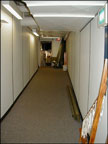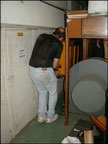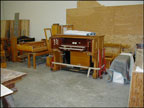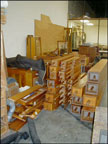
Patrick Allen Aeolian Skinner Organ Removal Story
Click a thumbnail to see a larger image.
On Monday, July 7, 2003, we drove up to Rochester, New York. Dave McCahan and I were in a car and made good time, arriving at the Eastman School of Music about 3 PM.
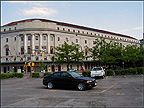
We were discouraged when we saw the situation we would be working in. We had seen many pictures of the organ we were to remove, a former practice organ no longer used, which had been purchased by Patrick Allen. But we hadnít seen how the organ would have to come out.
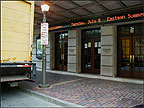
There was no real loading dock. We would have to park our truck at the main entrance of the school, and take the organ out through the main lobby.
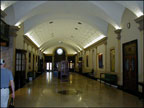
From the pictures I assumed we would be dropping the organ down from the attic on the 5th floor into the practice room on the 4th floor. However, there is a crawl space between the 4th and 5th floors, for mechanical access to all the organ stuff, so the practice rooms have very high ceilings, making that impossible. In addition this particular practice room had been made into an office for one of the Harpsichord professors. They did remove a pedal Clavichord from that room for safety, in case we dropped any organ parts down the sound chute from the attic.
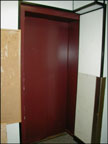
Eastman School of Music has two very old elevators, which are due to be replaced, after we moved the organ, as they didn't want us to damage the new elevators. The one on the right is 10' deep, and the doors open 34", so everything had to fit that parameter.
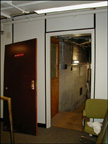
The door to the mechanical room wasn't 34", and the console was, so we had to take it off the hinges.
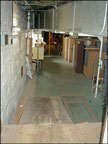
From the mechanical room door there was a ramp down to the floor, then we had to go to the end of the room and turn left.
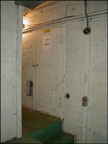
At the end of the mechanical room we had to go up steps to the tuner's passage between all the organ chambers. Each room originally contained an organ behind these fireproof and soundproof doors, which are not very high.
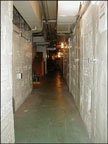
The room we would be removing the organ from was at the end of this hall, which contains two huge blowers that supply wind to all the various organs.
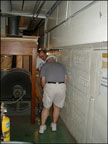
Here Steve Kimble and Dave McCahan are removing the blower of the organ we were taking out, having to lift it around one of the two huge blowers. Dave is mostly bald, and had already gouged his head once on the overhead air ducts, so he started using the hard hat, to protect his head. I'm sure each of us banged our heads at least once.
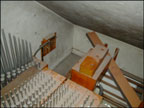
When I got into the organ chamber, I could see how dusty everything was, as the organ was installed in 1948, and had not been touched other than tuning since that time. The shades are the volume control for the organ, and they are flat on the floor over the sound chute down into the practice room below. Originally there were 10 practice rooms, with some of the larger rooms having studio organs of three manuals and several chambers full of pipes.
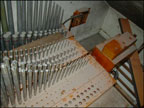
We've begun to remove the pipes, and I'll call your attention to the clean spots on the racks. That's where sweat had dripped off my nose as I pulled the pipes out. It was about 95 up in the attic. Eventually the head of instrument maintenance turned on the AC in the practice rooms, and opened up an air shaft between a couple of the chambers, so we could get some air flow, and he got us a fan. Until then we were dying in the heat. Since we couldn't get our pipe trays into the hall, we had to carry all the pipes down the tuner's passage and through the mechanical room, to a place that was clear enough to set up the trays. Then when we had a tray filled, we could carry it out to the elevator area. We had the bulk of the pipes out by 10 AM, loaded on the truck with the console. By then we were very tired and sweaty.
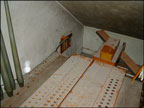
Most of the pipes have been removed, with just a few zinc basses too large to fit the pipe trays remaining. This time the spots are on the back walkboard, and again that's drops of sweat.
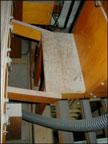
One of the fun things was removing the engine that moves the shades. We were looking down about 20 feet into the practice room below.
As of 6 PM Tuesday when we quit, we had only the main windchest, one offset windchest, the pedal windchest, the reservoir and the Swell shades remaining in the chamber. Our plan was to remove these the next morning, and be on the road home by noon. The hardest thing would be removing the Swell shades. We saved this for last, planning to unscrew the frame first, with the shades closed, and then remove the shades. Then we should be able to slide the frame back into the chamber, and take it apart and remove it, leaving a very large hole in the floor, which I hope we will have not fallen through or dropped anything through.
The people at the school have been very helpful. They have a lot of high school students there this summer taking classes and lessons, and they seem to be understanding when an elevator full of organ parts appears, and they can't get on, and we have to block it open as we unload.
We've discovered that loading the elevator is a lot like loading the truck. Everything gets stacked beside the elevator, then it gets loaded, then when we hit the lobby, it all gets unloaded into the center of the lobby. Then it gets taken to the street, where it gets loaded into the truck.
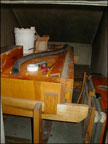
On Wednesday, July 9, we had just the few major items to get out and get on the truck. This is the view into the chamber. The main chest is still on the bearers, and the reservoir is on its side. We removed the two primary actions so the main chest wouldn't weigh as much, and then with four of us in the chamber, lifted the main chest, and removed the bearers, and then laid it on it's side, and it would just fit through the door. We took it into the airshaft and then were able to get it into the hallway.
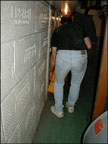
We let the two young bucks, Tony Drummond and Steve Kimble, carry the main chest past the two blowers, then Dave and I had enough space to assist them in getting it around the corner and into the mechanical room, where we could put it on a dolly and roll it to the elevator.
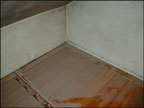
The shades down into the practice room have a clean spot where Tony rested while he took the shade engine loose. The missing dirt could be found on his jeans.
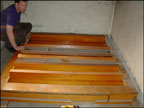
Tony took the trace off after he'd loosened the screws on the frame, and then we could remove the shades from the far end toward us. We only dropped one washer down into the practice room.
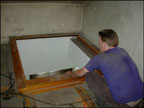
Then Tony pulled the frame back into the room, where we could safely take it apart away from the hole. More of the missing dirt is on the back of his shirt. That was from when he laid under the chest to take off the primary actions.
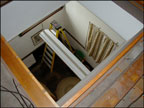
This is the view down into the practice room. The long white thing is a fluorescent light fixture suspended from the ceiling, and that's an 8 ft stepladder underneath it, so you get an idea of how high the ceilings are in those rooms.
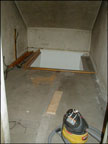
And this is the room just before the final cleaning.
The original cable between the console and the organ was covered in asbestos, so we just cut it and left it, as it was too dangerous to try to remove.
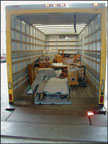
Unloading the truck at the factory on Thursday, July 10. Our toolboxes, the organ bench and several lumber items had already come off at this point.
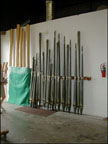
The zinc basses of the Swell 8' Viole de Gamba and Pedal 8' Spitz Principal are tied into racks we have on the wall of our office. The five gold pipes behind the pad are from the US Naval Security Station Chapel. We had to repair bashes in them caused by painters, and we want to keep them looking beautiful.
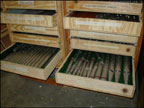
The eight trays of pipes in our morgue, all labeled and filed. Most of the guys took the rest of the day off, as we were all so tired, getting in at 10 PM the night before, and then unloading this morning. But we are all pleased that we were able to get the organ out and in our factory safely, and now are ready to start work on it.


